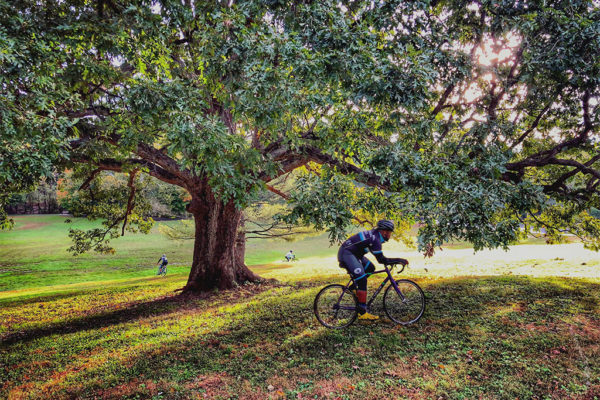Arlington’s sometimes controversial Public Spaces Master Plan was approved in a unanimous vote by the County Board on Thursday (April 25).
The idea of the update is to provide a framework for the county’s plans to preserve natural resources and public activities as part of the broader comprehensive plan. However, the meeting launched discussions over whether the county relies too much on paved public spaces, and how sports fields and mountain biking fits in.
Michael Hanna, a member of the Environment and Energy Conservation Commission, noted that while the plan would add to public spaces, more needed to be done to differentiate green space from other uses. County Board Member Katie Cristol agreed with Hanna later in the meeting, saying moving forward the county would need to do more to separate those uses.
“For a long time in our site plans, we’ve let concrete be public spaces,” Cristol said. “Plazas have a role, but in recent years [we] have tried to recognize the nature of biophilia.”
During the years-long public engagement process about the plan, which was last updated in 2005, arguments emerged over what shape Arlington’s public space should take. County staff said there were several issues raised by the public in the final stretch of the approval process that would require future assessment after the plan’s approval.
One source of public consternation throughout the planning process was what critics said was inflated estimates of demand for sports fields. Peter Rousselot, an ARLnow columnist and leader of the Parks4Everyone advocacy group, argued that athletics fields were being over-reserved rather than over-used, an inefficiency leading to an artificial appearance of demand.
County Manager Mark Schwartz noted that the county is reviewing its scheduling process. The plan includes analyzing field utilization to improve data on current and projected uses as a priority for the plan.
The final version of the plan also swapped the earlier estimates of future need with a more general arrow indicating whether demand is expected to increase or decrease. The language concerning the need for two additional diamond fields by 2035 was changed from “Arlington will need…” to “Arlington could need…”
Still, Justin Wilt, a member of the county’s Sports Commission, stood by the earlier projected needs and said his commission urged the construction of at least one multi-use athletic center in Arlington, citing a lack of indoor recreation activities in the county.
Another group advocating for a space in the plan were mountain biking enthusiasts. Several mountain biking advocates attended the meeting, including a parent who said he had to take his children out to Reston to access mountain biking trails.
“I’m here to support off-road cycling facilities in Public Spaces Master Plan,” said Grant Mandsager, a public speaker at the hearing. “These facilities are in high demand and can be a great benefit to Arlington residents.”
While staff said there was a demand to add mountain biking-specific paths to the plan, the potential impact on natural resources in areas those paths would cut through would require further study.
“The advisory committee felt this issue raised too late in the process,” said Hanna. “To proceed with mountain biking… all ramifications need to be examined, particularly the threat to natural resources.”
In the end, the approved version of the plan settled on:
“Interest was also expressed in mountain biking, however, prior to exploring potential locations for mountain biking, the community would need to have a more robust and broad conversation.”
Parks4Everyone said in a statement this weekend that it was pleased with the final Public Spaces Master Plan, which “has the potential to address community needs, maintenance, and field priorities through data-driven transparency and prioritization of financial resources and land being appropriately allocated.”
“Only after residents pushing, Commissions digging in, and a decisive January 8th Civic Federation vote… did the PSMP become more reflective of the core issues affecting our parks,” the group said. “The PSMP needed to convey the priorities and needs of the vast majority of Arlingtonians including more trails, green open space parks, and natural areas.”
The final version of the plan also included several recommendations highlighted as actions critical to the success of Arlington’s public space system:
- Add at least 30 acres of new public space over the next 10 years.
- Secure or expand the public spaces envisioned by sector, corridor and other plans adopted by the County Board – including the Clarendon Sector Plan, Virginia Square Sector Plan, Courthouse Sector Plan, Rosslyn Sector Plan, Crystal City Sector Plan, and Columbia Pike Form Based Codes – and ensure they provide amenities that meet the county’s needs.
- Utilize level of service as a planning tool to manage public space assets efficiently.
- Analyze athletic field utilization to improve data on the current use and assess future athletic field needs.
- Ensure access to spaces that are intentionally designed to support casual, impromptu use and connection with nature.
- Complete the implementation of adopted park master plans.
- Develop park master plans for all new parks or when renovation of an existing park requires a major rearrangement of park amenities.
- Ensure and enhance access to the Potomac River, Four Mile Run and their tributaries while improving the tree canopy, native vegetation, and other natural resources along waterways.
- Expand Arlington’s network of connected multi-use trails.
- Update the Urban Forest Master Plan and Natural Resources Management Plan through a combined process.
- Protect, restore, and expand natural resources and trees
Prior to the County Board’s 5-0 approval of the plan, Chair Christian Dorsey noted that few parties would be fully pleased with the compromises made in the plan.
“It’s an exceptional document that reflects an extraordinary effort,” said Dorsey. “I realize there are people engaged in this project who aren’t thrilled with everything that they see, but again, if we take that non-specific, line by line lenses and look at it comprehensively, we have to recognize that this is a tremendous step forward.”
Flickr pool photo by Dennis Dimick


